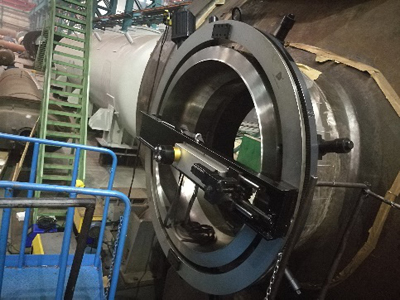5 reasons your flange facing connection is failing
Date: 2018-08-29 Clicks: 9376
Over time, and for many other reasons, damage occurs to flanges that effects their performance and safety.
Of course the success of a fitted flange is that the connections between the flange, gasket, bolting and pipework create a leak-free environment. More importantly, the connection between the flange faces needs to be up to the same standards to achieve the same outcome.
To ensure you’ve done as much as you can to repair your flange facing connection, check these 5 common ways that damage effects flange performance:
Gouges
Wide and elongated damage across the flange face, usually created by a blunt object such as a screwdriver or flange jack. Gouges significantly reduce the likelihood of creating a leak-proof seal.
Dents
Dents usually occur from equipment collisions caused by a mis-positioning of the mating flanges using cables and rigging.
Pits
Small and rounded damage areas that cause a loss of material, these often occur in clusters and are normally created by corrosion across the flange face surface.
Incorrect fabrication
One of the more common problems associated with flanges is that of poor fabrication. Sometimes the flange have been fitted to the pipe in the wrong position or at the wrong angle which makes creating a tight seal impossible.
Repairing these problems
If you’ve found one of these problems, it can be a frustrating period in between downtime before the flange can be reconnected to the system. To avoid downtime and costs spiralling out of control, AOTAI can help you repair your flange on-site with no need to send the product back to the workshop.
Designed to ANSI standard surface finish, AOTAI’s range of portable flange facing machines can repair damage such as scratches and corrosion on faces up to a diameter of 120” fast, saving you time and money.
Once more,AOTAI’s machines use industry standard turning tools apart from the 3 smallest machines in the range, meaning you can source replacements locally. Non-standard tooling for 3 of the smallest machines can be sent to you via AOTAI in an over-night delivery.
Of course the success of a fitted flange is that the connections between the flange, gasket, bolting and pipework create a leak-free environment. More importantly, the connection between the flange faces needs to be up to the same standards to achieve the same outcome.
To ensure you’ve done as much as you can to repair your flange facing connection, check these 5 common ways that damage effects flange performance:

Scratches
Gouges
Wide and elongated damage across the flange face, usually created by a blunt object such as a screwdriver or flange jack. Gouges significantly reduce the likelihood of creating a leak-proof seal.
Dents
Dents usually occur from equipment collisions caused by a mis-positioning of the mating flanges using cables and rigging.
Pits
Small and rounded damage areas that cause a loss of material, these often occur in clusters and are normally created by corrosion across the flange face surface.
Incorrect fabrication
One of the more common problems associated with flanges is that of poor fabrication. Sometimes the flange have been fitted to the pipe in the wrong position or at the wrong angle which makes creating a tight seal impossible.
Repairing these problems
If you’ve found one of these problems, it can be a frustrating period in between downtime before the flange can be reconnected to the system. To avoid downtime and costs spiralling out of control, AOTAI can help you repair your flange on-site with no need to send the product back to the workshop.
Designed to ANSI standard surface finish, AOTAI’s range of portable flange facing machines can repair damage such as scratches and corrosion on faces up to a diameter of 120” fast, saving you time and money.
Once more,AOTAI’s machines use industry standard turning tools apart from the 3 smallest machines in the range, meaning you can source replacements locally. Non-standard tooling for 3 of the smallest machines can be sent to you via AOTAI in an over-night delivery.
The key words of this article:

